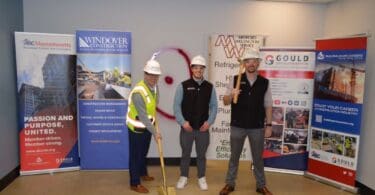Fall is officially here! October is HP’s annual focus on Corporate and Interiors. With employees returning to the office, the spotlight is on interior design firms to ensure workers feel comfortable, safe, and healthy.
Design firms are reimagining what a workspace looks like and how it accommodates the new normal, sometimes scrapping the traditional private office for a collaboration space. John Kells, director of interior design at Maugel Architects, states, “Your office design must inspire employees to willingly forgo the comfort and convenience of working from home. If it does not, they will look elsewhere.”
On a personal note, I’ve been working autonomously from home since the early 2000s. If I was to return to an office, it would have to have a huddle room to retreat to for my daily nap. Check out page 22 to see what I’m referring to.

Current office design trends include huddle rooms and flexible collaboration areas to promote wellness and connection as workers return to the office.
I recently attended the Massachusetts Building Congress’ (MBC) “Escalating Construction Costs – Part 2” event, a continuation of the conversation that was first held virtually in May of this year. Moderated by Eric Hubert of Vermeulens, the conversation was focused on how rising costs of commodities have affected us on a local level. Panelists included Jared Lachapelle, V.P. of Consigli; Kevin Walsh of E. M. Duggan, Inc.; and Michael P. Sams of Kenney & Sams, P.C. Lachapelle explained that, although a shortage of workers is still an issue, Consigli’s biggest challenge as of late has been the uncertainty of costs and the delivery of materials. What does that mean for writing contracts? Sams suggests that we “be precise in the language of the contract” and that “communication amongst the trades is key.” My takeaway was that, in the current environment, knowing how to manage risk is crucial and companies in the AEC space should lead with careful optimism.
 I also recently attended ULI’s Walking Tour of Cambridge Crossing, a 43-acre transit-oriented community at the intersection of Cambridge, Somerville and Boston (East Cambridge), comprised of residential units and life science and retail space. This new development will be featured in next month’s issue, HP’s annual focus on Life Science facilities.
I also recently attended ULI’s Walking Tour of Cambridge Crossing, a 43-acre transit-oriented community at the intersection of Cambridge, Somerville and Boston (East Cambridge), comprised of residential units and life science and retail space. This new development will be featured in next month’s issue, HP’s annual focus on Life Science facilities.
Be sure to visit High-Profile’s booth at the New England Building Facilities Management (NEBFM) Conference on Nov. 10-11 at the new venue, the DCU Center in Worcester. See page 50 for HP’s full calendar of events.
As always, enjoy the read,
Anastasia Barnes












